Part of this article stemmed from a reader's question about Charlie Morton. Then I discovered several intriguing metrics, particularly with Morton's curveball. Morton has struggled this season at age 38, which led me to look at other players fared after turning 38.
Among others, Justin Verlander, Adam Wainwright, Zack Greinke, Nelson Cruz and Joey Votto are 38 or older this season. I'll save the hitters for an upcoming article and focus below on Morton and Verlander.
Will Morton bounce back? Is Verlander back to the prime ace pitcher? What do the skills indicate?
Charlie Morton
The track record for Morton made him a seemingly safe option as a top-75 pick in Main Event leagues. Morton's track record made him a seemingly safe top-75 pick in Main Event leagues, but in 67.1 innings this season he has a 5.08 ERA and 1.37 WHIP — versus a career 4.06 ERA and 1.31 WHIP. The graph below shows how ERA rises and falls with BABIP.
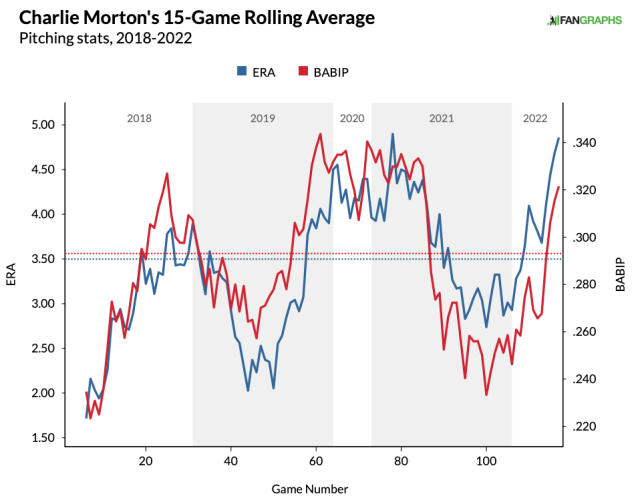
Morton's BABIP is .333 this season after a career .305 BABIP, with a drop in groundballs and a jump in home runs. Morton's 1.34 HR/9 is his highest since 2010 (1.69). Unsurprisingly, it aligns with the career-low 35.3 GB%.

After a career K-BB% ranging from 18-23 percent, this season it's 14.8 percent. Morton's strikeout percentage has dropped to 24.4 while his walk percentage has increased to 9.6. Even Morton's overall SwStr% at 10.5 hasn't looked the same, with a 11-13 percentage from 2016 to
Part of this article stemmed from a reader's question about Charlie Morton. Then I discovered several intriguing metrics, particularly with Morton's curveball. Morton has struggled this season at age 38, which led me to look at other players fared after turning 38.
Among others, Justin Verlander, Adam Wainwright, Zack Greinke, Nelson Cruz and Joey Votto are 38 or older this season. I'll save the hitters for an upcoming article and focus below on Morton and Verlander.
Will Morton bounce back? Is Verlander back to the prime ace pitcher? What do the skills indicate?
Charlie Morton
The track record for Morton made him a seemingly safe option as a top-75 pick in Main Event leagues. Morton's track record made him a seemingly safe top-75 pick in Main Event leagues, but in 67.1 innings this season he has a 5.08 ERA and 1.37 WHIP — versus a career 4.06 ERA and 1.31 WHIP. The graph below shows how ERA rises and falls with BABIP.

Morton's BABIP is .333 this season after a career .305 BABIP, with a drop in groundballs and a jump in home runs. Morton's 1.34 HR/9 is his highest since 2010 (1.69). Unsurprisingly, it aligns with the career-low 35.3 GB%.

After a career K-BB% ranging from 18-23 percent, this season it's 14.8 percent. Morton's strikeout percentage has dropped to 24.4 while his walk percentage has increased to 9.6. Even Morton's overall SwStr% at 10.5 hasn't looked the same, with a 11-13 percentage from 2016 to 2021.
Morton's Pitch Arsenal & Results
Perhaps his best pitch, Morton's curveball has not generated the same rate of groundballs this season as his career or last year (both about 50 percent) at just 42 percent. The groundball rate of his four-seamer has also dropped from 37.3 percent in 2021 to 22.1 in 2022, with a career 37.5.

Morton has a couple other pitches with a lower groundball rate that are likely contributing to the overall drop. However, the four-seamer and curveball have also allowed a higher HR/FB% at 11.1 (four-seam) and 16.7 (curve). It's not a massive increase, but he has a career HR/FB% of 10.0 on the fastball and 12.1 on the curve.
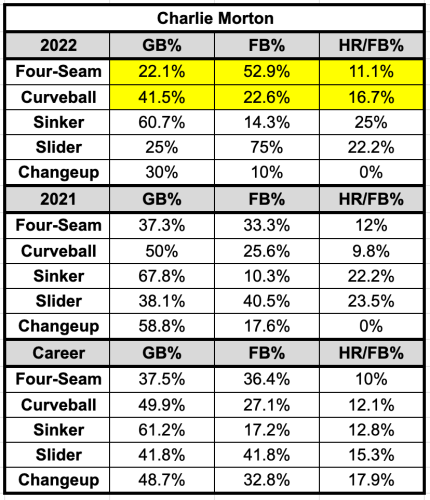
Unsurprisingly, Morton's SwStr% on the curveball at 15.5 dropped from 17.7 in 2021, though not far off from the career rate at 16 percent. The four-seamer also has a lower SwStr% at 7.0 versus 9.7 in 2021 and a career 8.3. Morton's four-seamer has allowed more Z-Contact% and Contact% with alarming contact quality metrics.
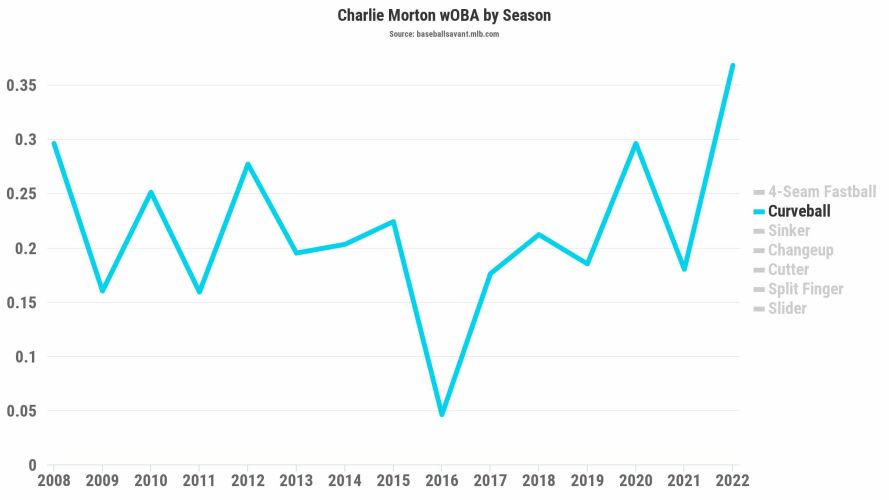
Batted ball results on the four-seamer and curve are awful. The four-seamer has allowed a .277 BA, .436 SLG and .348 wOBA. Meanwhile, Morton's curveball has nearly identical results with a .272 BA, .506 SLG and .368 wOBA. The numbers have improved in June, especially on the curveball with a .143 BA, .286 SLG and .247 wOBA. However, the four-seamer still gets crushed with a .684 SLG and .426 wOBA in June.
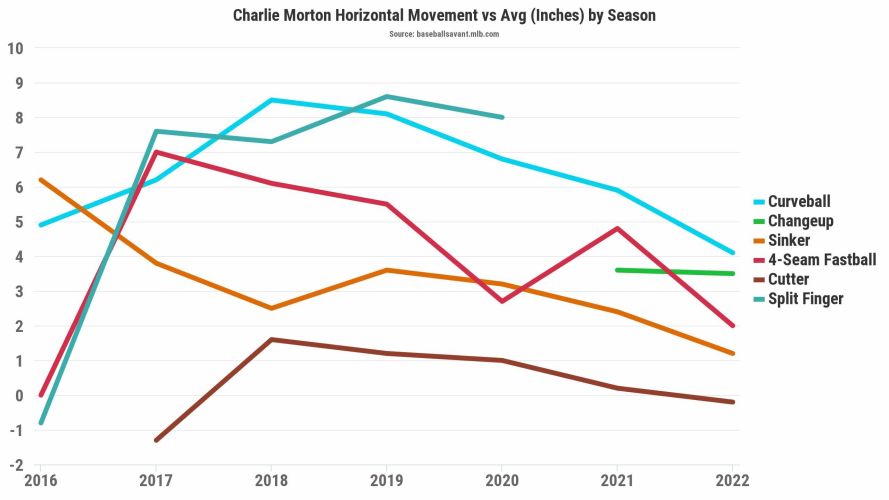
The last few seasons, the horizontal movement on Morton's curveball and four-seamer broke less. In Morton's peak seasons (2017-2019), the curve had 17.8-18.6 inches of break, nearly seven inches more than the average. Morton's curveball possesses 15.3 inches of break (4.1 vs. Avg.) in 2022, which dropped from 16.6 inches (5.9 vs. Avg) in 2021.

With the movement changes, the average spin rates changed with north of 3,000 RPM on the curveball versus 2,800-2,900 (2017-2019), plus an increase in velocity of 1-2 mph. Morton's extension on the curveball increased in 2022 to 6.1 feet versus 5.3-5.6 feet (2017-2019), which is an interesting observation.
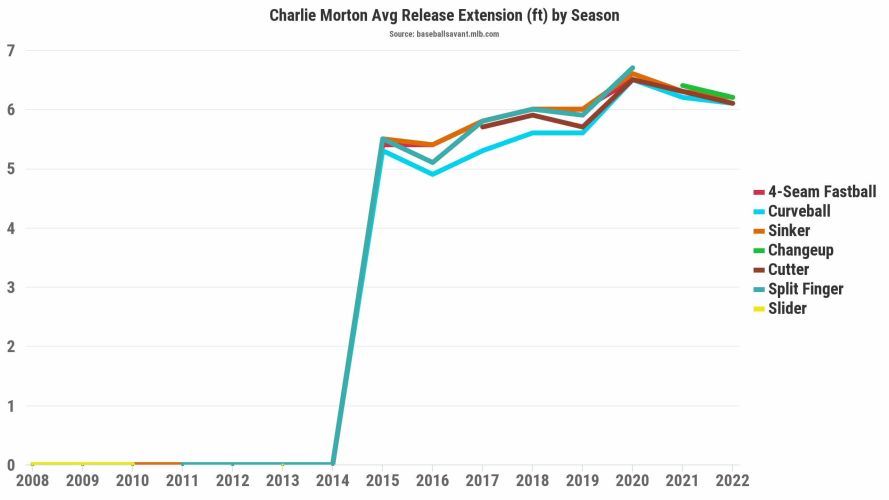
That indicates Morton is releasing the curveball closer to the plate than in his peak seasons, which could add to the puzzle of movement, velocity and spin rate changes, possibly impacting the curveball's effectiveness.
Takeaways
What started as a seemingly "simple" examination of Morton turned out to be must more. Assuming the groundball and flyball rates regress on the four-seamer and curveball, the positive results should follow with the overall GB% and fewer home runs. The same hope applies to the batted ball results and SwStr%, as we hope those metrics regress closer to the career norms.
However, the most intriguing area to monitor for Morton might involve the curveball's movement profile, spin rate and velocity. That might mean checking the Statcast player breakdowns or looking at the rolling charts. Although I'm not sure how fixable it is for Morton, it's worth buying low with potential paths for improvement and positive regression.
Justin Verlander
Throughout the draft season, I faded Justin Verlander with concerns about his long layoff. Verlander has elite ratios with a 1.94 ERA and 0.81 WHIP in 78.2 innings. Although Verlander is a unicorn, the .204 BABIP and 86.8 LOB% should regress closer to the career BABIP of .279 and LOB% at 75.4.

Verlander's 26.3 K% and 5.1 BB% translates to a 21.2 K-BB%, higher than the career K-BB% of 17.8. During Verlander's peak seasons, he had a K-BB% north of 30 percent in 2018 and 2019. Verlander's 11.2 SwStr% aligns with the career norms, though it's hard to compare to the 2018 and 2019 seasons. His 94.8 mph four-seamer velocity aligns with past seasons, so it looks like Verlander is back to his typical self.
Verlander's Pitch Arsenal & Results
Unsurprisingly, the batted ball results remain elite with .336 SLG and .267 wOBA versus the four-seamer. Verlander's slider has quality numbers, evidenced by an 18.4 SwStr%, .257 SLG, and .214 wOBA.
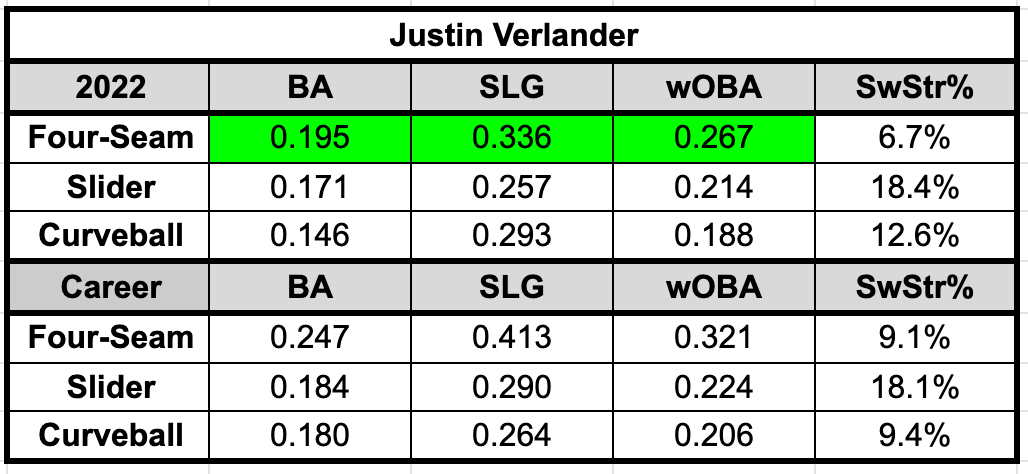
If we bake in regression on the four-seamer, Verlander's results on the slider and curveball remain identical. It's another positive indicator for Verlander.
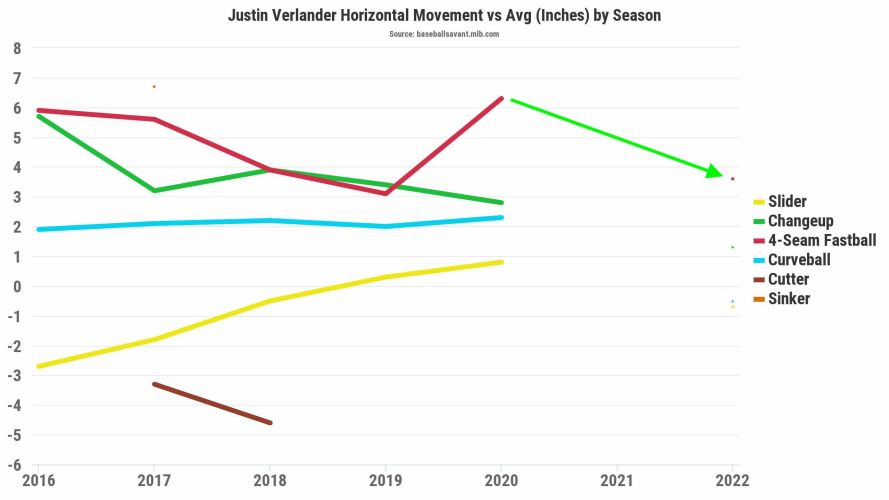
Thankfully, Verlander's movement profiles on the four-seamer look similar to the peak 2018 and 2019 seasons, translating into above-average horizontal movement in 2022. The same trend has occurred with the slider via the drop and break.
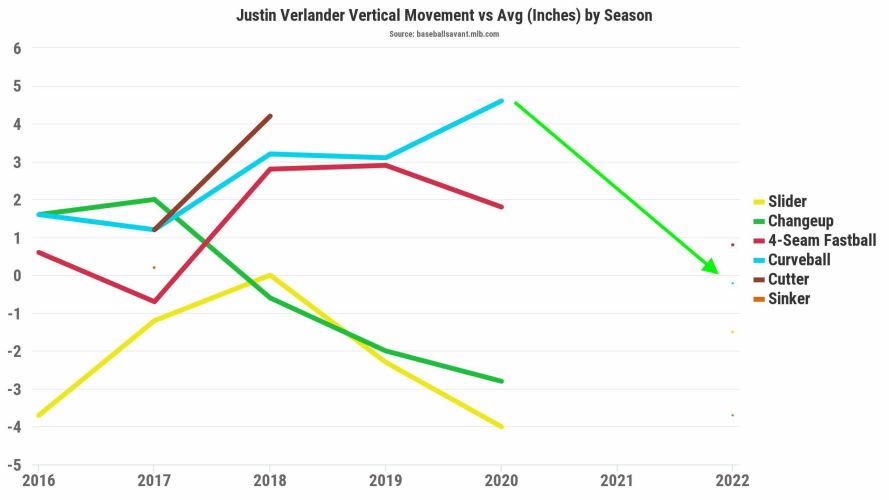
Verlander's curveball isn't dropping or breaking as much compared to 2018 and 2019. We note that because Verlander's curve typically boasted an above-average movement profile. The curveball velocity dropped about one mph, but the spin rate decreased by nearly 300 RPM. Overall, it's still an effective pitch but something to monitor throughout the season.
Takeaways
The RotoWire Earned Auction Values have Verlander at $29, ranking him as a top-30 player. Given the ADP ranging from pick 50 to 100, it's probably positive value for anyone who rosters him. Even if we bake in regression in the BABIP, LOB% and the four-seamer, the stuff and results look similar in most of the underlying metrics. It's hard to sell high with the pitcher injuries and offensive surge, so hold and ride the wave.







































